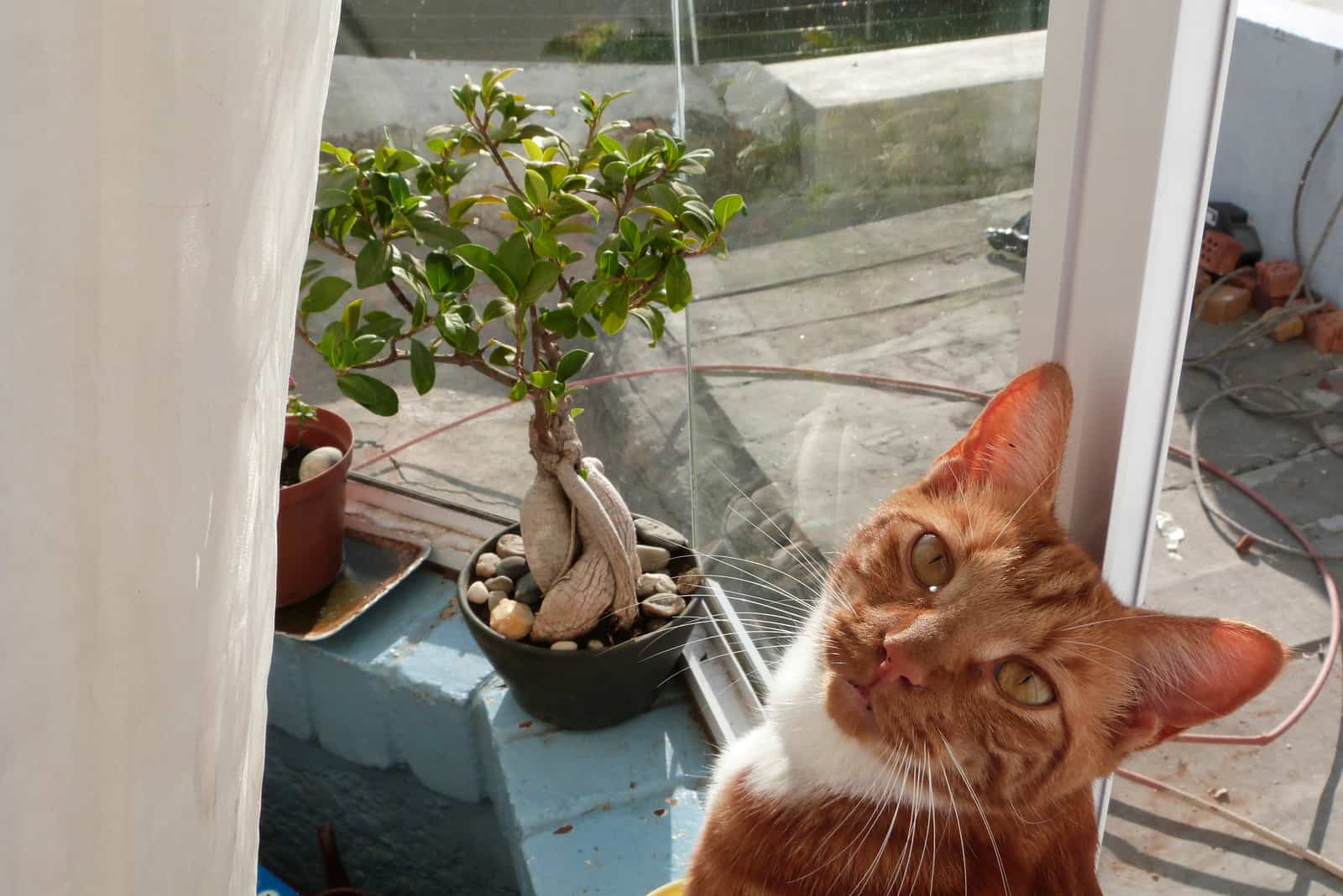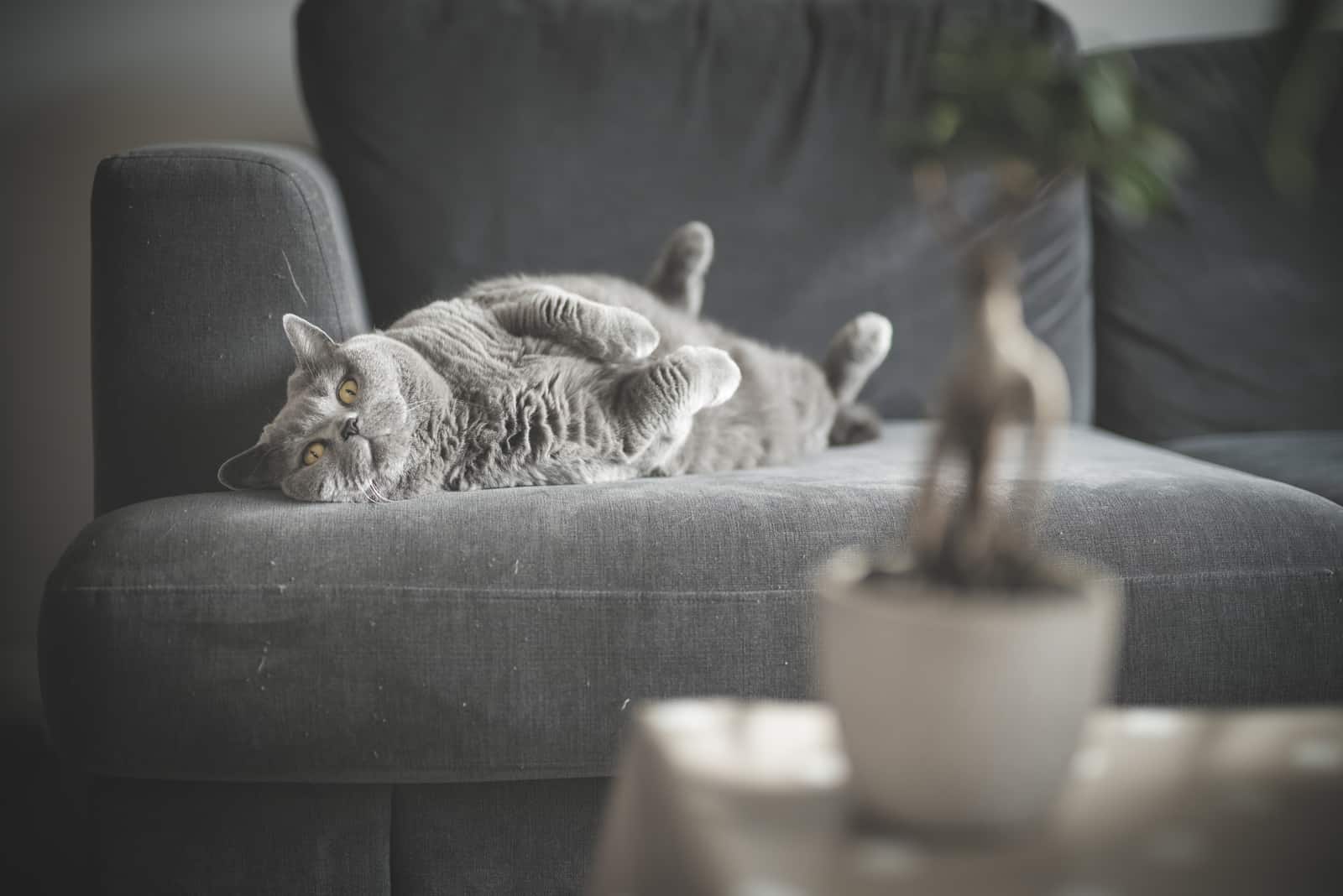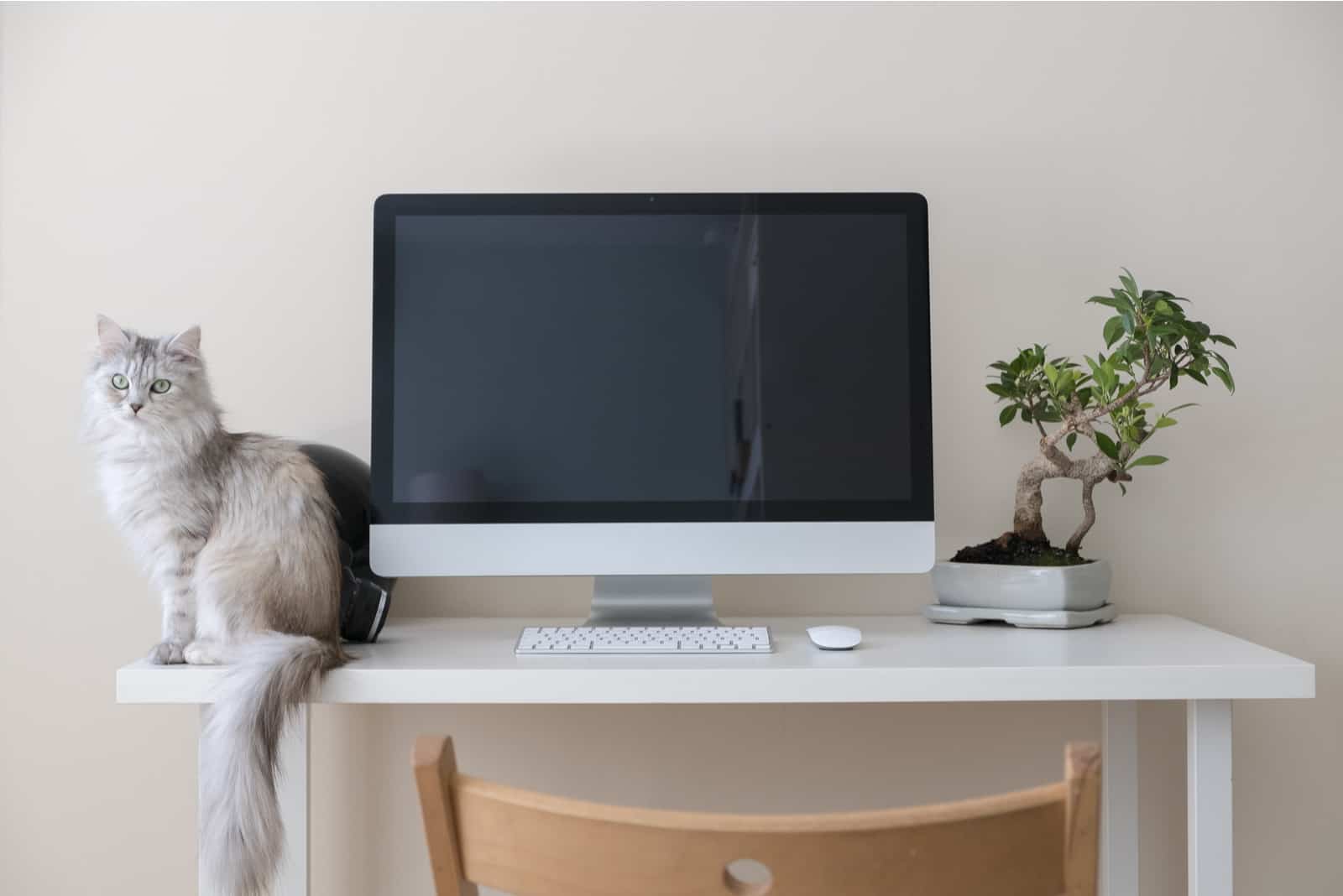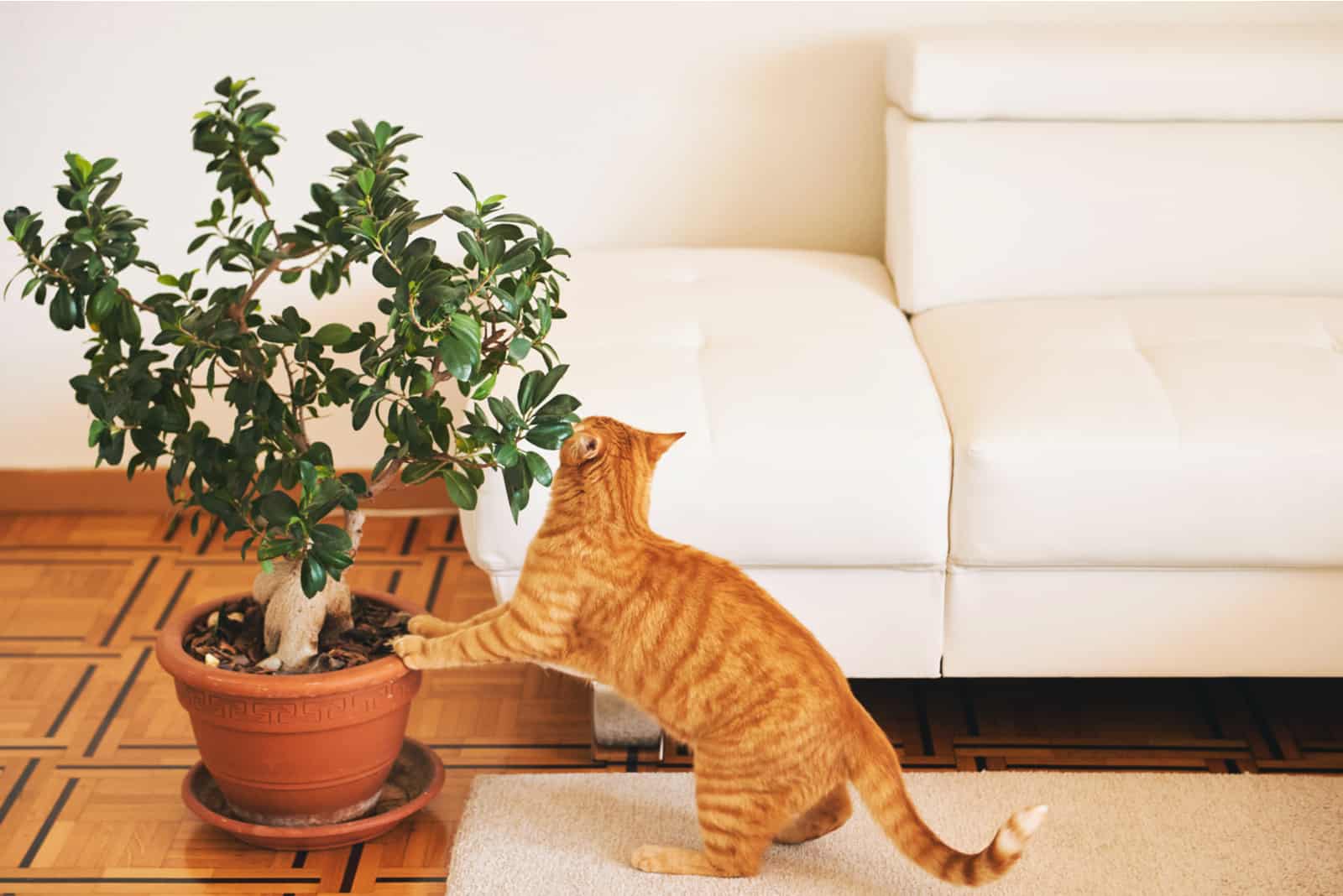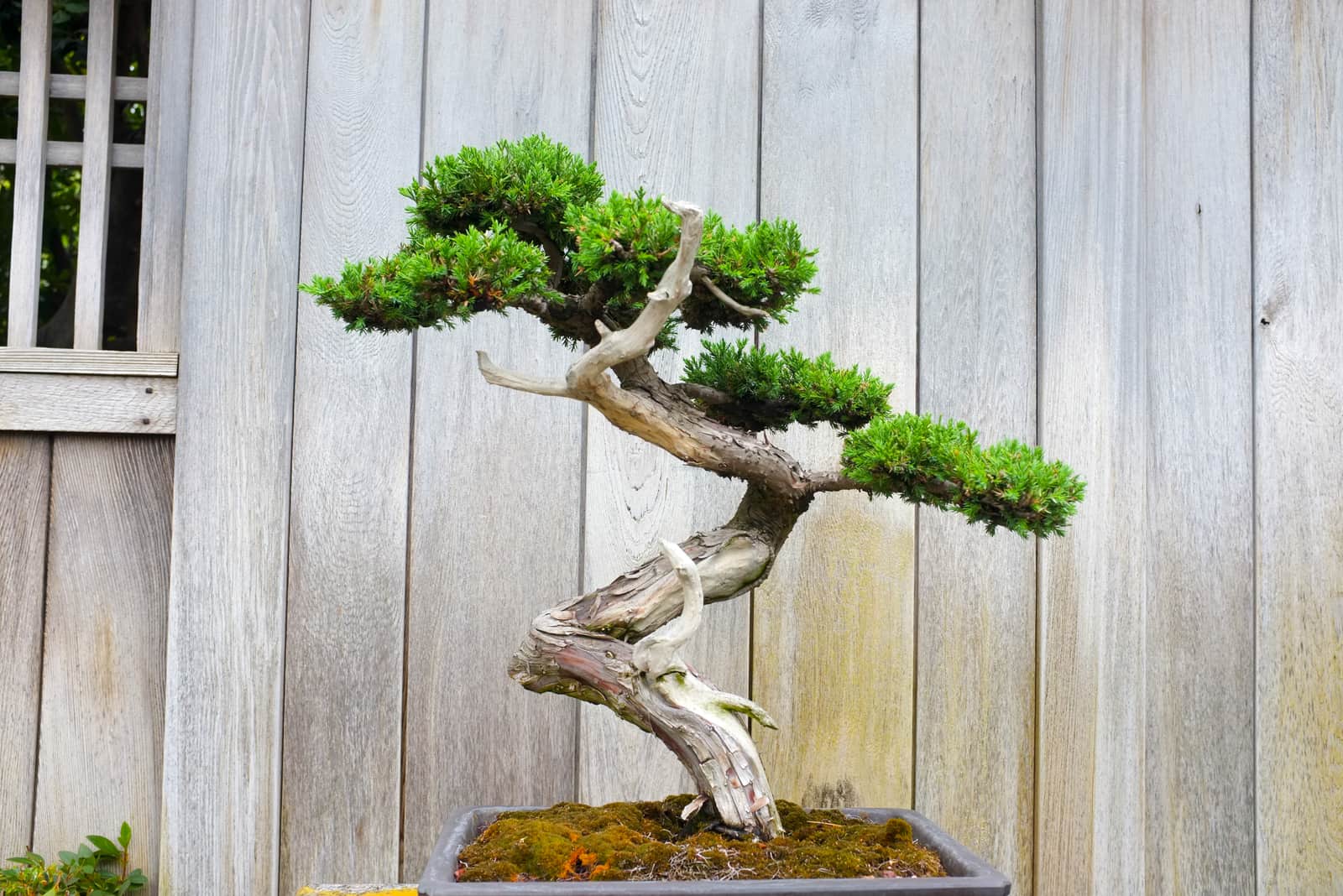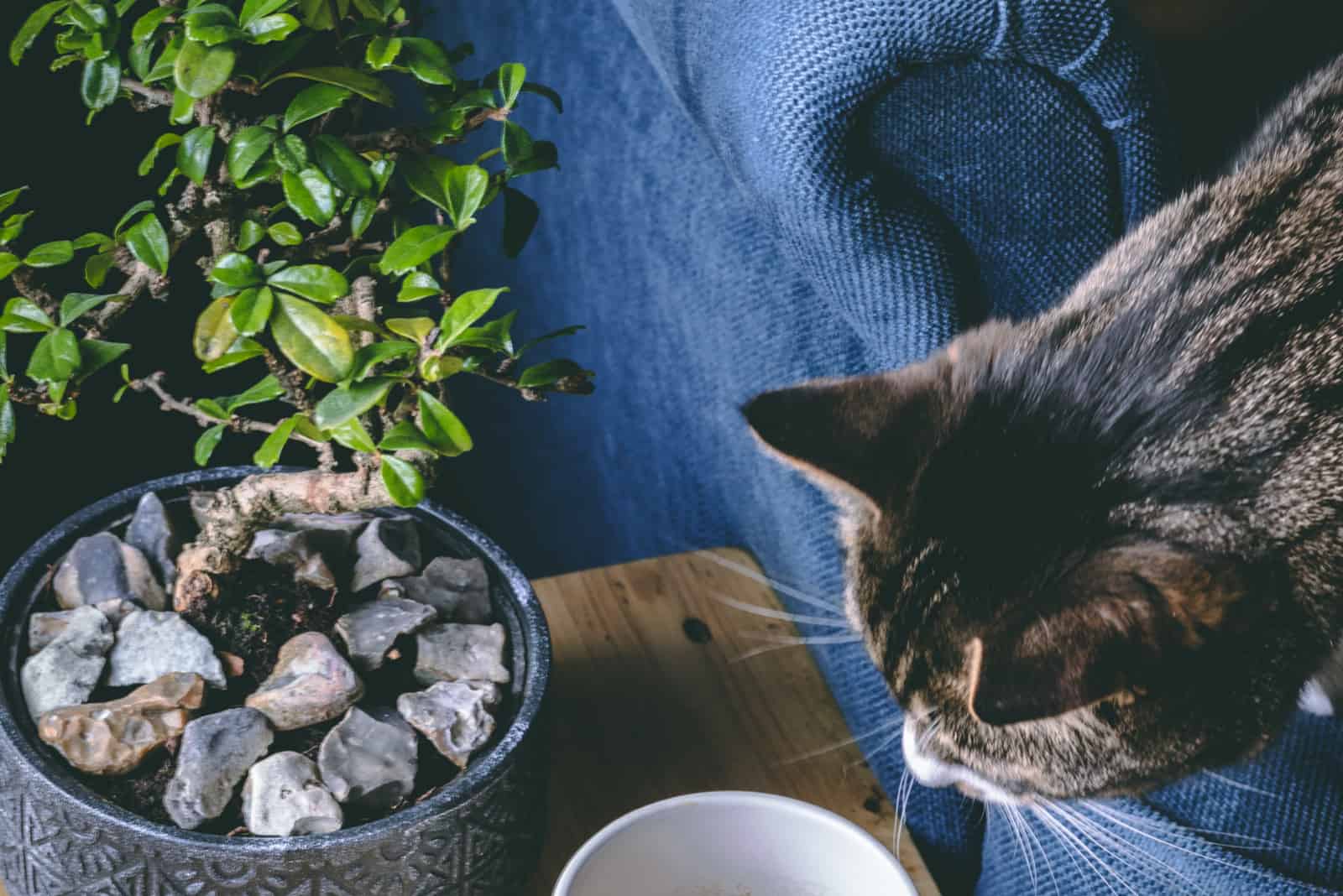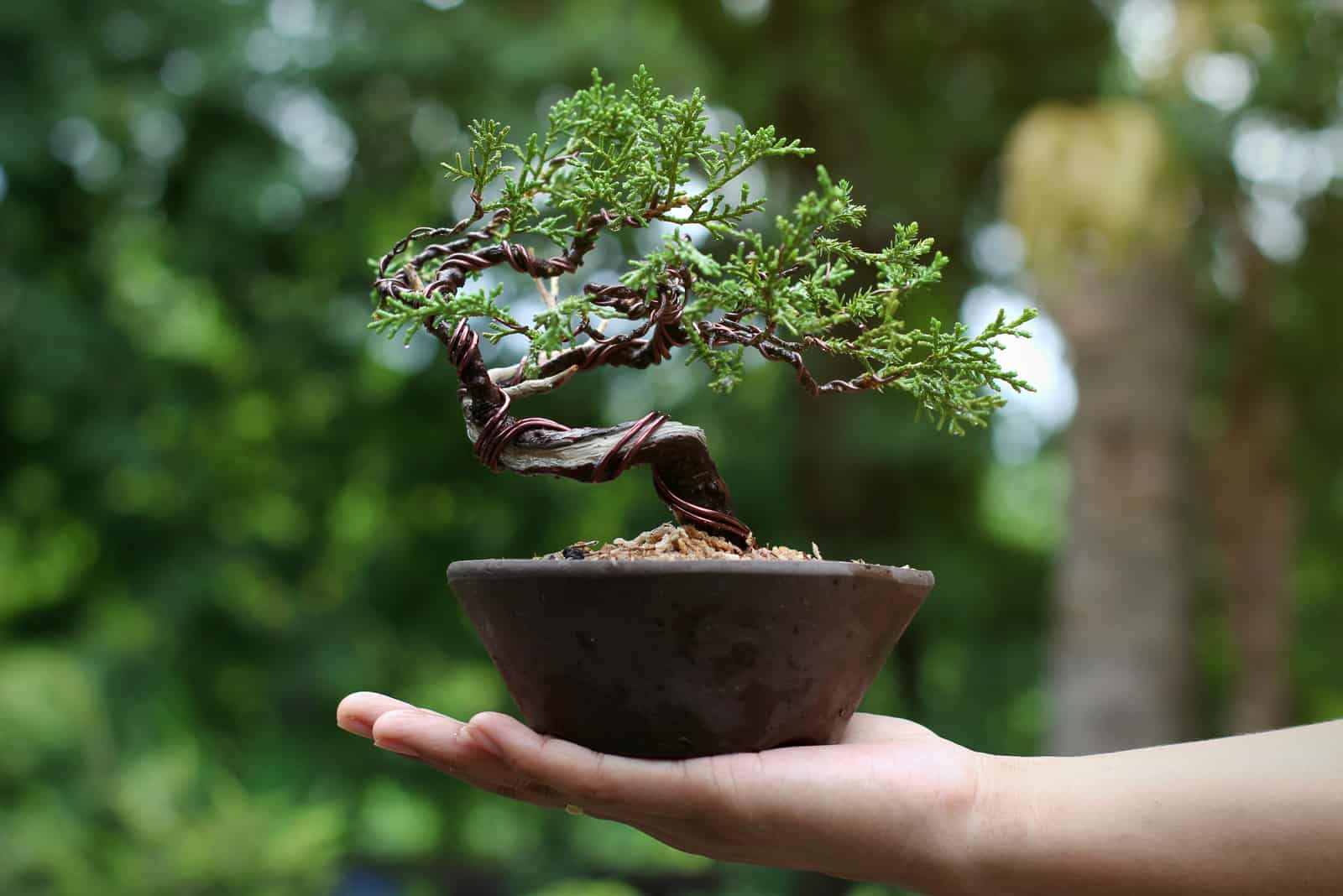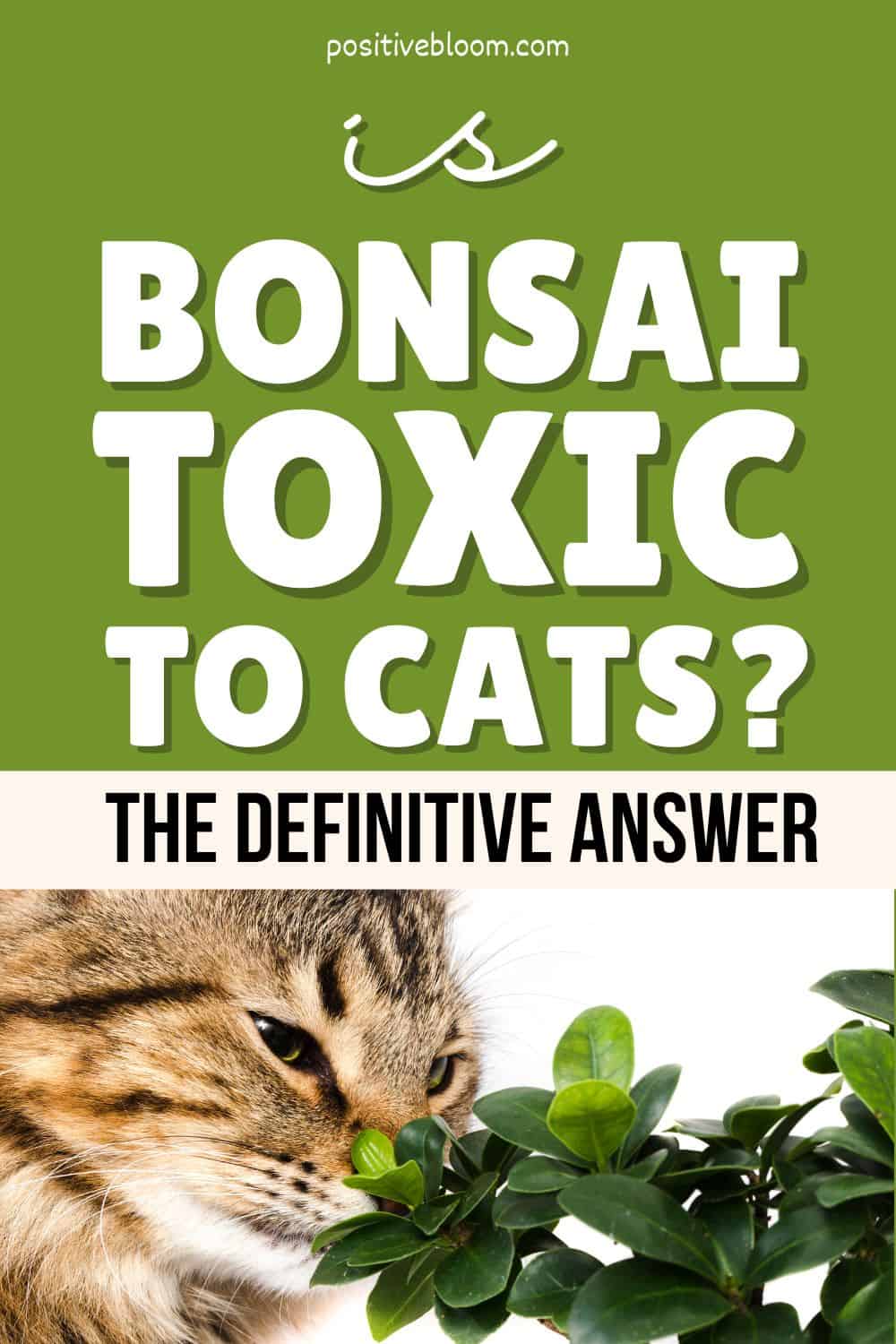A bonsai tree is a perfect addition to any miniature garden, but you may be worried about your pet and wondering, “Is bonsai toxic to cats?”.
There are many conflicting answers to this question, but you will find the definitive answer below.
We’ll also look at some bonsai varieties that are safe and not-so-safe for your cats, and present the symptoms and treatments of bonsai poisoning.
We will also answer some common questions about bonsai to help you out even further. There’s so much to learn about this amazing plant!
Let’s get started!
Is Bonsai Toxic To Cats?
This is an important question for gardeners, so we decided to investigate the matter a bit further.
Unfortunately, most bonsai are toxic to pets. Your cat or dog could even die if they ingest large quantities of certain plant leaves!
There are different bonsai species, and not all of them contain the same toxins dangerous to animals. Plants don’t poison other living beings on purpose; it is their defense mechanism to fend off predators.
Some plants are more toxic than others, but it’s all the same to your pet that is suffering.
Therefore, it’s good to know the symptoms and treatments for bonsai poisoning. You can read all about it in the following sections and save your pet some serious trouble!
Symptoms Of Bonsai Tree Poisoning
Bonsai plants aren’t usually pet friendly and can cause many issues related to the heart, liver, and respiratory system of animals.
However, there are many symptoms of poisoning that may actually save your pet’s life if you recognize them and act quickly enough.
Some common symptoms of ingesting toxic plants are loss of appetite, vomiting, drooling, diarrhea, lethargy and depression, seizures, shivering, and even coma.
Your pet may experience difficulties breathing and pupil dilation. Black stool and slow heart rate are also relatively common, and some pets may even suffer from skin irritations. Finally, your pet may drink more water and urinate more frequently due to poisoning.
The good news is that pets start vomiting and get diarrhea if the toxicity level is particularly high. I say it’s good news for two reasons: first, your pet will throw up some of the toxins, and two, you’ll immediately know that something’s not right with your cat and seek professional help.
However, some symptoms may occur rather late, which means your furry friend will likely ingest at least a small amount of toxins.
This is why you must always be on the lookout if you own a toxic bonsai tree species.
How To Treat Bonsai Poisoning
The best way to treat bonsai poisoning is by preventing it from happening in the first place, but if you notice that a branch is missing from your beautiful bonsai tree you shouldn’t scold your pet, but try and save it!
The main thing is to safely remove any plant parts you may find in your pet’s mouth and wash it out with water.
You may feel inclined to induce vomiting in your cat, but you may only end up hurting it, which will only make matters worse and harm you both in the process.
You should call a vet or pet poison control clinic if you suspect that your cat has consumed large amounts of a poisonous houseplant, if you notice any signs of bonsai tree poisoning, or if you only suspect ingestion of poisonous plants.
It’s always better to be safe than sorry!
Also, try not to lose your head in the process; your pet will thank you for keeping a cool head!
You can always take a small sample with you so your vet knows what toxin your pet has ingested because different substances require different treatments.
How To Keep Pets Away From Poisonous Plants
If you have recently bought a new bonsai and your cat seems to enjoy it as much as you do, you should look for specific ways to keep your beloved pet away from this miniature tree because it can be deadly.
Plant and cat owners are always coming up with creative and ingenious ways of keeping their pets away from their plants, but it might be a bit more difficult for beginners.
There’s nothing to worry about, though, because we did the hard work for you – and we will now go through our favorite ways of keeping both your plants and pets safe.
Place The Bonsai Up High
If you cannot bear to part with your new baby jade even though you know it’s not the best choice for a cat owner, you should place it somewhere your pet cannot reach it.
However, cats are among the most athletic animals and enjoy acrobatics, so ensure that there isn’t any furniture nearby that could aid a resourceful feline in getting to your bonsai.
Make A Special Space For Your Plant
Another thing you can do is make a special place just for your plant. It could be a sanctuary and a safe space where you go to relax and gather your thoughts.
However, you can turn it all around and make a space just for your pet as well. Fence it off and make it comfortable so your cat doesn’t want to leave in the first place!
Distract Your Pet
Finally, you could distract your cat one way or another. You can either play with it or give it something to nibble on like catnip, cat thyme, or silverine.
There are some fantastic cat toys on Amazon, and you should definitely get a scratching post to keep your furniture safe and your pet busy and away from your plants!
What Are Bonsai?
We talked about bonsai plants being poisonous, and also mentioned that many of them contain different toxins, but how could that be if we’re talking about the same plant?
The thing is that bonsai trees aren’t just one plant. I know, I was surprised when I first found that out as well!
Bonsai is not a variety of trees, but rather a Japanese art that involves growing miniature and artificially dwarfed shrubs and trees in small pots and containers.
Therefore, almost any tree can be a bonsai if you prune it correctly. You shouldn’t only trim it above the soil because the plant’s roots also need pruning if your goal is to make a dwarf tree.
Bonsai trees are quite popular because they look like regular, fully grown trees grown in small and shallow pots that can fit on your coffee table.
Bonsai Trees Safe For Your Pets
Now that you know what bonsai is, let’s take a look at a few types of bonsai trees that are safe for pets, but still make a great addition to your garden.
Hibiscus Bonsai
Hibiscus trees are an amazing choice whether you want to grow them inside or outside your home. They aren’t toxic, which makes them a fantastic option for an indoor bonsai tree.
The hibiscus tree attracts hummingbirds and other pollinators, which makes it an ideal garden tree as well (and your cat would enjoy climbing it).
Japanese Maple
The Japanese maple is another cat-safe tree, and the red leaves that appear in fall would look breathtakingly beautiful in your modern design.
Bamboo Palm
Unlike some other palms, the bamboo palm is actually safe for cats.
Prune it frequently and it can look like a miniature jungle, or you can let it grow and enjoy its leaves that way.
Christmas Cactus
The Christmas cactus bonsai has stunning pink flowers that will definitely attract your pets.
However, your cat will be safe because it isn’t poisonous.
Prayer Plant
Our last option is prayer plants. They look fantastic whether or not you decide to grow them as bonsai.
If you do go for this plant, you should know that prayer plants can get droopy due to overwatering and underwatering, poor water and soil quality, and overfertilization among other things.
Toxic Bonsai Trees
Now that you’ve seen some fascinating and non-toxic bonsai varieties, it is time to look at a few that aren’t exactly safe for your pets.
According to the ASPCA, the plants below are considered more or less toxic and can harm your pets. If you don’t want to risk it, you should choose a pet-friendly bonsai species.
However, you can always place the toxic plant somewhere your pets can’t reach it and monitor your feline friend so it doesn’t accidentally eat it!
Juniper Bonsai Tree
Juniper trees produce savin oil, which is incredibly toxic and can lead to severe kidney damage if ingested in large quantities.
Therefore, both you and your pet should stay away from its attractive berries and foliage at all times!
Boxwood Bonsai
Boxwood plants contain alkaloids buxine, cyclobuxine, and cycloprotobuxine, which are rather harmful to large animals like horses and livestock, as well as your pets.
Even though this butter-like oil won’t cause serious damage to you, it will to your pets, so place it somewhere out of their reach.
Thankfully, your pets would need to eat a lot in order to experience life-threatening issues, and this doesn’t usually happen because buxine is rather bitter.
Plum And Cherry Trees
Even though we find plums and cherries delicious and healthy, smaller animals might not agree.
Both of these fruits contain cyanide, which is toxic to your pets even though you might not feel any harmful consequences.
Cyanide inhibits the absorption of oxygen, causing your pet to eventually suffocate.
Fig Tree
Figs are a popular fruit, but unfortunately, they’re dangerous to your pets. They contain the toxin called ficin, which will enter your pet’s bloodstream once ingested.
It also becomes toxic when it comes into contact with your pet’s mouth, eyes, or skin, so keep them separated at all times!
Norfolk Island Pine
Don’t let the attractive looks fool you; it would be incredibly unsafe for your cat to eat this!
Even though it is still debatable whether or not this tree is toxic, it can still lead to dermatitis and gastrointestinal issues in your pets.
Chinese Rubber Plant
This plant is also known as Ficus elastica and contains latex in its milky sap, which makes it toxic to small children and pets.
Even though the sap is usually not toxic, it can still cause severe irritations to the gastrointestinal system, mouth, and skin.
Cardboard And Sago Palm Tree
Unlike the Fukien tea and jade plant, which are mildly toxic to pets, sago palm bonsai contains cycasin, which is highly poisonous and can lead to liver failure if eaten by your pet.
The Cardboard palm, also known as the coontie palm, is another plant that contains cycasin and BMAA (beta-methylamino-alanine), a neurotoxin that can be lethal.
Azaleas
The Azalea is a small shrub in the Rhododendron genus and is among the houseplants that love acidic soils.
But despite their attractive flowers, azaleas contain grayanotoxins, which inhibit the normal functions of your pet’s organs and nervous system. It will eventually lead to kidney and liver failure, bleeding, gastrointestinal issues, and pneumonia.
Ambrosia Mexicana
The last toxic bonsai we’ll examine in this article is Ambrosia Mexicana, which contains oxalates, nitrates, and cyanogenic glycosides.
A high concentration of oxalates may lead to bladder stones. Nitrates turn to nitrite compounds that combine with hemoglobin, which loses its ability to carry oxygen and suffocates your pet.
Finally, cyanogenic glycosides produce cyanide when metabolized, which is incredibly harmful!
You Asked Us
There are still a few more things we need to discuss about bonsai before calling it a day, which is why we decided to answer some of your most frequently asked questions about these miniature trees!
Are bonsai trees toxic to humans?
Certain types of bonsai trees can be toxic to humans, but it would require ingesting large doses before it becomes life-threatening.
We don’t usually ingest lethal doses, so we end up with gastrointestinal issues, skin and mucosa irritations, and rashes.
What is the average height of a bonsai tree?
It is up to the grower to decide what size of tree they prefer, but it can range from anywhere between a few inches and 60-80 inches.
There are many different sizes of bonsai trees. The largest bonsais belong to the class referred to as Imperial (up to 60-80 inches tall), whereas the smallest bonsai tree size is called Keshitsubo (1-3 inches tall).
What is the average number of years a bonsai takes to grow?
It usually takes between 5-10 years to grow a bonsai tree, depending on whether you grow it from the seed or sapling and what the weather conditions are like.
Finding out how long it takes bonsai to grow is essential when deciding which variety you want to plant because some types can take up to 30 years to mature.
To Wrap Up
The goal of this article was to answer one critical question: “Is bonsai toxic to cats?”
Bonsai trees are usually toxic to pets, but there are non-toxic varieties that your pets will adore and feel safe around.
There are more toxic than non-toxic bonsai species, so we looked at some common poisonous trees that should be ok as long as you’re careful with your pets around them.
Finally, we included the most common symptoms and ways of dealing with bonsai tree poisoning so you know what to do if your pet ever does eat a bonsai.
Keep your pets safe, and until next time!
Like this post? Share or pin it for later!

